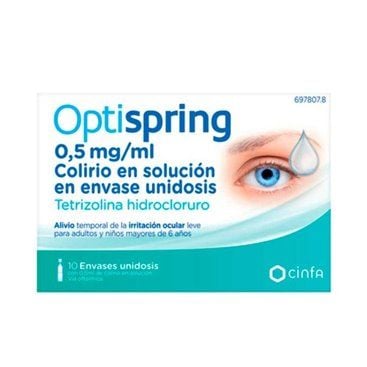Optispring 0.5 Mg/Ml Eye drops 10 Monodose 0.5Ml
Optispring 0.5 Mg/Ml Eye Drops 10 Monododis 0.5Ml is indicated for the temporary relief of mild eye irritation for adults and children over 6 years of age.
Optispring 0.5 Mg/Ml Eye Drops 10 Monododis 0.5Ml is indicated for the temporary relief of mild eye irritation for adults and children over 6 years of age.
Optispring (0.5 Mg/Ml Eye Drops In Solution 10 Monodose 0.5 Ml)
ACTION AND MECHANISM
- Eye decongestant. Adrenergic, it acts by producing vasoconstriction at the conjunctival level and as a consequence a decrease in conjunctival congestion. The effects last approximately 6 hours.
INDICATIONS
- Temporary symptomatic relief of [CONJUNCTIVITIS] (stinging, [EYE IRRITATION], itching and excessive tearing) due to eye allergies, minor irritations and non-specific catarrhal conjunctivitis.
POSOLOGY
- Adults and children over 6 years: 1 or 2 drops in each eye 2-3 times a day as needed. Maximum 4 times a day.
- Children from 2 to 6 years: always administer under strict medical supervision.
- Children < 2 years: contraindicated.
RULES FOR CORRECT ADMINISTRATION
- Wash your hands.
- Look up. Pull down the lower eyelid to make a sac.
- Bring the dropper as close to the bag as possible without touching the eye. To avoid contamination of the medication, it is important that the tip of the applicator does not come into contact with any surface (including the eye).
- Apply the prescribed amount of coliro to the bag.
- Blink a few times to spread the drop over the entire ocular surface.
- Close the eye for about two minutes (do not close it too tightly) or press the nasolacrimal edge to reduce systemic absorption.
If another topical ophthalmic medication is being used, this medication should be administered at least ten minutes apart. Eye ointments should be administered last.
CONTRAINDICATIONS
- Allergy to the drug.
- [CLOSED ANGLE GLAUCOMA] or predisposition to it, since it can aggravate the disease.
- Children under 2 years old.
PRECAUTIONS
- It can mask the symptoms in patients with [EYE INFECTION].
- Given the possibility of systemic absorption, it should not be used indiscriminately in [ARTERIAL HYPERTENSION], [ANGINA PECTOR], [CORONARY FAILURE], [HYPERTHYROIDISM], [DIABETES], [PHEOCHROMOCYTOMA].
- Patients under treatment with MAO inhibitors or other potential risers of blood pressure.
- Patients with dry rhinitis and [KERATOCONJUNTIVITIS].
ADVICE TO THE PATIENT
- If relief is not obtained in 2 days, or if redness increases or persists, discontinue use and consult a doctor.
- Treatment should not exceed 7 days. Prolonged and frequent use can cause congestion and dry eyes.
- Because it contains benzalkonium chloride as an excipient (except in the case of a single-dose presentation), which can cause eye irritation and discolor or alter the color of soft contact lenses, it is recommended to avoid using this medicine if wearing the contact lenses. The lenses have to be removed before the application and can be put on at least 15 minutes after instilling this medicine.
- If severe eye pain, headache, rapid changes in vision, rapid appearance of floating spots, acute redness of the eye, pain after exposure to light or double vision occur, the clinical situation should be evaluated.
PREGNANCY
Animal safety : No animal studies have been conducted.
Safety in humans : There are no adequate and well-controlled studies in humans. It is not known whether tetrizoline ophthalmic can cause fetal harm when administered to a pregnant woman; possible systemic absorption should be taken into account. Although fetal harm is not expected with the use of moderate doses for a short time (not more than 3 days), the use of this medication is only accepted in the absence of safer therapeutic alternatives.
LACTATION
It is not known whether tetrizoline is excreted in breast milk. The possible systemic absorption of ophthalmic oxymetazoline should be taken into account as young children are more sensitive to the pharmacological and toxic effects of sympathomimetics. Precautionary use, always using moderate doses for no more than 3 days.
CHILDREN
Contraindicated use in children under 2 years of age. In children from 2 to 6 years of age, use only under medical supervision. Children, especially the youngest, may be more sensitive to the toxic effects derived from systemic absorption. Likewise, in children, eye redness may appear due to diseases that may need medical attention, such as allergies, fever, colds or measles. The use of tetrizoline eye drops is not recommended in children under 6 years of age. The use of moderate doses is always recommended for no more than 3 days.
SENIORS
The safety and efficacy of tetrizoline ophthalmic use in the elderly have not been specifically established, however, the elderly may be more sensitive to the adverse effects of sympathomimetics. It should be taken into account that these patients are more prone to undiagnosed angle-closure glaucoma, so caution is recommended in its use, always using moderate doses for no more than 3 days.
ADVERSE REACTIONS
- Occasionally, [EYE IRRITATION], burning, [BLURRED VISION], [DRY EYE], [MYDRIASIS].
With excessive use or high doses: rebound congestion (redness and irritation).
- Exceptionally, signs of systemic absorption: headache, palpitations, nervousness, nausea, sweating, headache, increased blood pressure and weakness.



